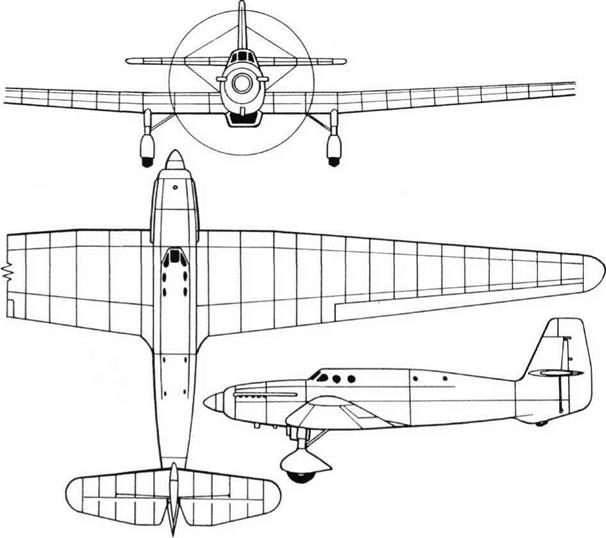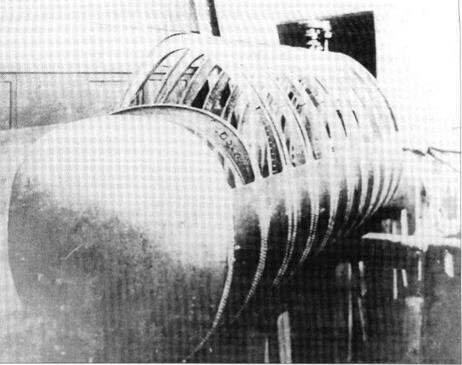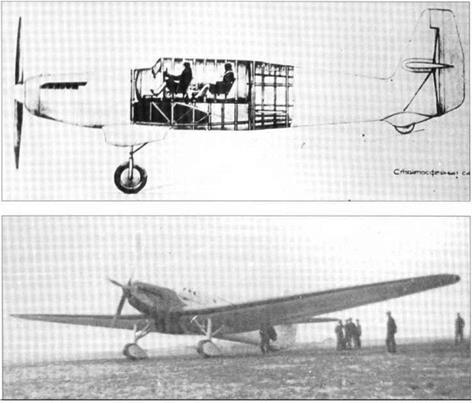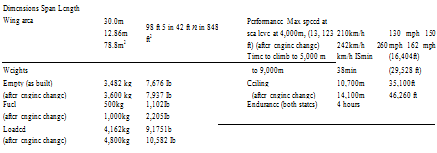BOK-1, SS
Purpose: To investigate high-altitude flight, and if possible set records.
Design Bureau: The Byuro Osobykh Konstruktsii, the Bureau of Special Design, Smolensk. BOK was formed in 1930 in Moscow as a subsidiary of CAHI (TsAGI) to build experimental aircraft ordered by the Revolutionary Military Council. Despite starting on existing projects it made slow progress, and in September 1931 was transferred to the CCB (TsKB) as Brigade No 6. It had undergone other transformations, and been relocated at Smolensk, by the time work began on BOK – 1. Director and Chief Designer was Vladimir Antonovich Chizhevskii.
One of the bureau’s first assignments was to create an aircraft to explore flight at extreme altitudes, seen as ‘Nol priority’. Close links between the USSR and Junkers resulted in BOK sending a team to Dessau in 1932 to
study the Ju 49, and in particular its pressurized cabin. This strongly influenced their thinking, and led to many studies for a Soviet counterpart, but the only hardware built was the balloon SSSR-1, with a pressurized gondola, which in 1933 exceeded 18km (59,055ft). In 1934 a major conference of the Academy of Sciences issued a programme for future research, one requirement being a high-altitude aircraft. The contract for the SS (Stratosfernyi Samolyot, stratospheric aeroplane) was signed with BOK.
By this time Tupolev had designed the long – range RD (ANT-25), and to save time BOK used this as the basis for the BOK-1. The main task was to design the pressure cabin, but there were many other major modifications. The BOK-1 was built at GAZ (State Aircraft Factory) No 35 at Smolensk, where it was first flown by I F Petrov in (it is believed, in September) 1936. It was repeatedly modified in order to climb higher. It was successfully put
throughGOSNIl-GVF State testing by PM Ste – fanovskii. Shavrov speaks of’ a lighter variant’ achieving greater heights, but there is no evidence of a second BOK-1 having been built.
The airframe was originally that of one of the military RD aircraft, but modified by GAZ No 35. The span was reduced by fitting new constant-taper outer panels, restressed for significantly reduced gross weight achieved by greatly reducing the fuel capacity. The massive retractable twin-wheel main landing gears were replaced by lighter fixed units with spatted single wheels. The engine was an AM-34RN liquid-cooled V-12, rated at 725hp, driving a three-blade fixed-pitch propeller.
The main new feature was the pressure cabin, seating the pilot and a backseater who acted as observer, navigator and radio operator (though no radio was ever installed). This cabin was a sealed drum of oval cross-section, with closely spaced frames to bear the
|

bursting stress, constructed of Dl light alloy with 1.8 or 2.0mm skin riveted over a sealing compound. Design dP (pressure differential) was 0.22kg/cm2 (3.2 lb/in2). The front and rear were sealed by convex bulkheads. The entry hatch was at the rear and an escape hatch was provided in the roof. One report says there was no room for parachutes, which were stowed in the rear fuselage. There were five small glazed portholes for the pilot and one on each side ahead of the backseater. There were also four small portholes to admit light to the unpressurized rear fuselage. A regenerative system circulated the cabin air and removed carbon dioxide (one report says ‘and nitrogen’). A controlled leak through a dump valve was made good by oxygen from bottles to keep oxygen content approximately constant. The engine cooling circuit heated a radiator covering the cabin floor to keep internal temperature at 15-18°C.
Flight testing revealed satisfactory flying characteristics and a lack of vibration. On the other hand, on any prolonged flight the cabin became uncomfortably hot. Despite this, and electric heating of the portholes, the glazed surfaces quickly misted over. In any case, external vision was judged dangerously inadequate.
Shavrov states that the cabin was qualified for flight to ‘8,000m and more’; this is ambiguous, and the original design objective was that the interior should be equivalent to an altitude of 8,000m (26,250ft) at the design ceiling of the aircraft. The engine cooling circuit was modified, and the portholes were replaced by double-layer sandwiches with not only electric heating but also a dessicant (moisture absorber) between the panes. This overcame the condensation, but nothing could be done to improve field of view.
In spring 1937 the BOK-1 was fitted with an 830hp M-34RNV engine, driving a four-blade fixed-pitch propeller. This engine was then fitted with two TK-1 turbosuperchargers, designed by VI Dmitriyevskiy so that the combined turbo exhausts also added a thrust of 70kg (1541b). With the new engine installation the altitude performance was much improved (see data), but during an attempt to set a record for height reached with 500 and 1,000kg payload one of the turbos blew up. Shavrov says merely ‘the attempt failed’, but another account says the exploding turbo seriously damaged the forward fuselage and resulted in the BOK-1 being scrapped.
The BOK-1 was only the second aeroplane in the world to be designed with a pressure cabin. It achieved most of its objectives, but failed to set any records.


 Top: BOK-1 pressure cabin. Centre: BOK-1 inboard profile. Bottom: BOK-1 (final form).
Top: BOK-1 pressure cabin. Centre: BOK-1 inboard profile. Bottom: BOK-1 (final form).










